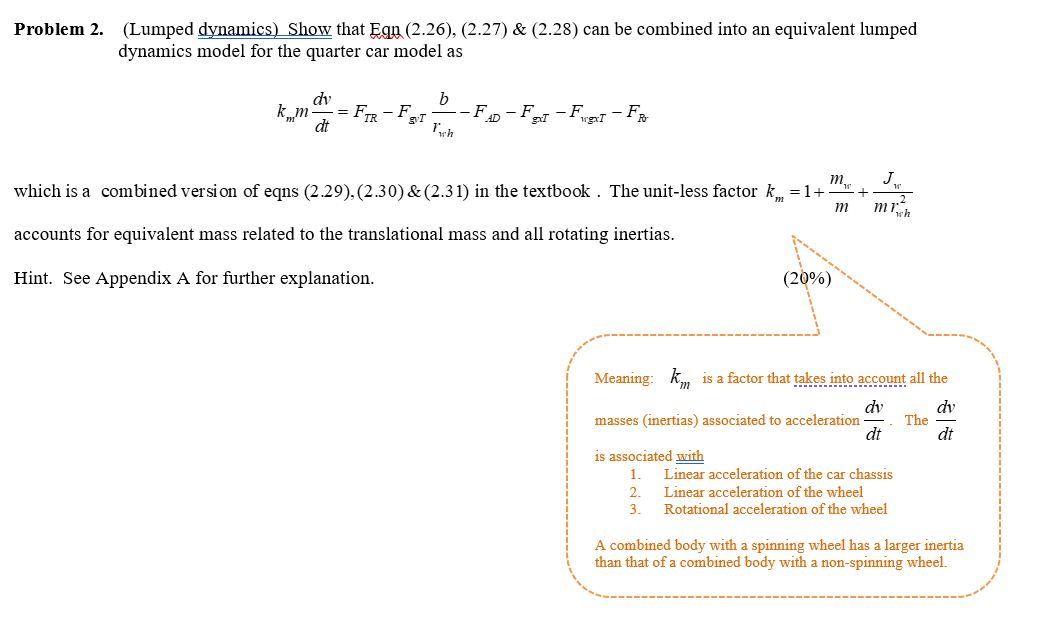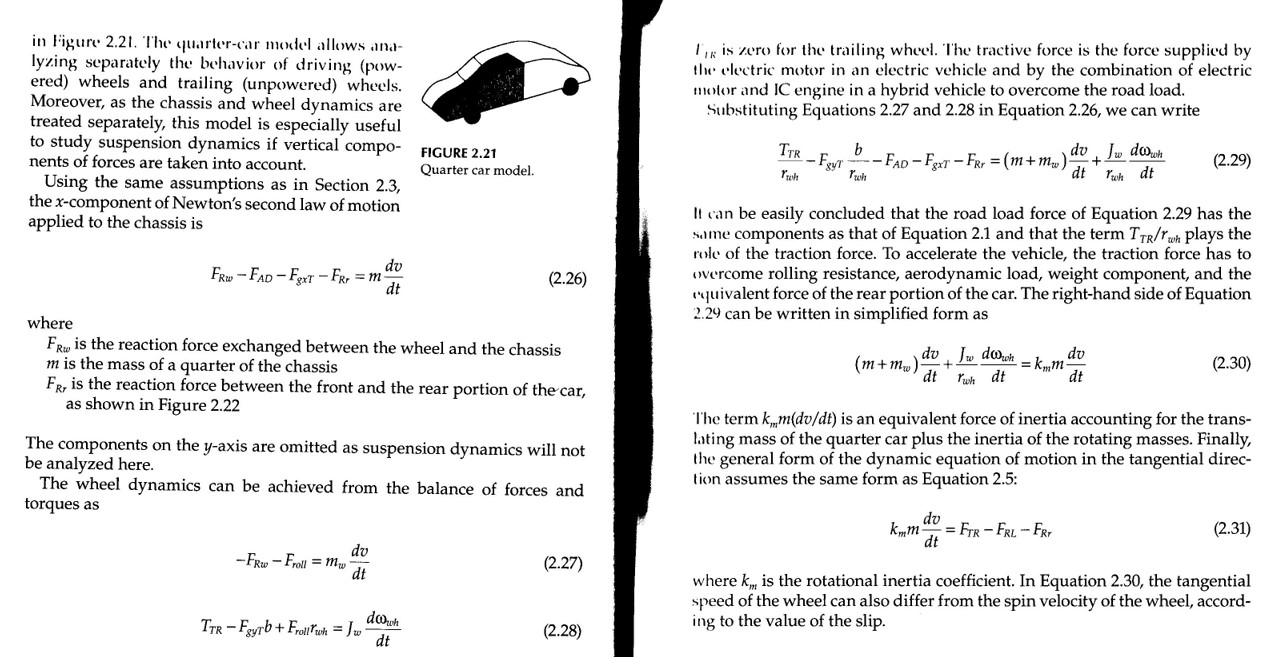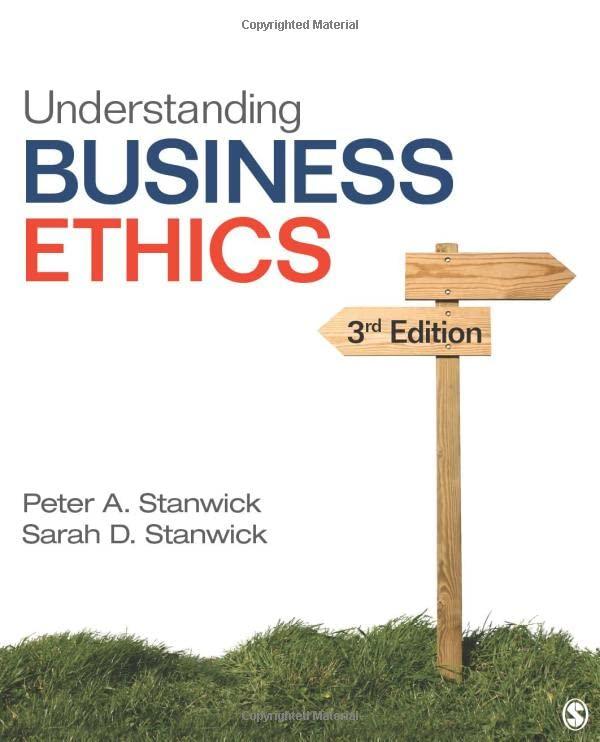Answered step by step
Verified Expert Solution
Question
1 Approved Answer
Problem 2. (Lumped dynamics) Show that Egn (2.26), (2.27) & (2.28) can be combined into an equivalent lumped dynamics model for the quarter car




Problem 2. (Lumped dynamics) Show that Egn (2.26), (2.27) & (2.28) can be combined into an equivalent lumped dynamics model for the quarter car model as dv km FIR - FI --FAD-FT-FgxI - FR dt b Tich m J m mrch which is a combined version of eqns (2.29), (2.30) & (2.31) in the textbook. The unit-less factor k = 1+ + accounts for equivalent mass related to the translational mass and all rotating inertias. Hint. See Appendix A for further explanation. (20%) Meaning: K masses (inertias) associated to acceleration is a factor that takes into account all the dv dv dt dt is associated with 1. 2. 3. Linear acceleration of the car chassis Linear acceleration of the wheel Rotational acceleration of the wheel The A combined body with a spinning wheel has a larger inertia than that of a combined body with a non-spinning wheel. Appendix A: Rotational Inertia Coefficient k Example 1. A box sliding up or down a slope k = 1 X F B m Example 2: A wheel rolling up or down a slope k, = 1+ X mg sin p bx Mw F mg sin Roll dx d dt di mx = -mg sin -bx + fx x, x= J mww X x mx=FRoll-mg sin FRollforce the pushes the ball up or down the slope * = r,0 J=Tw-FRoll Tw-Fgrb w X, X, X FIGURE 2.21 Quarter car model. 0, 0, 0 FAD FR -1 FOT Jw W T W b FgT F Roll mg sin p J Froll W J X W You are to perform similar analysis for the quarter car in Prob 2 of HW1. Instantaneous center of rotation TTR 400 D FOT For Frell W X TwTw J Tw (m. + 2) = -- mg sin -Farb W X Tw W = -(m, x+m,g sin 3) - Frb W Tw Tw = km mw This is the factor that takes rolling inertia into account as the wheel accelerates. -(m+mg sin )-Farb in Figure 2.21. The quarter-car model allows ana- lyzing separately the behavior of driving (pow- ered) wheels and trailing (unpowered) wheels. Moreover, as the chassis and wheel dynamics are treated separately, this model is especially useful to study suspension dynamics if vertical compo- nents of forces are taken into account. Using the same assumptions as in Section 2.3, the x-component of Newton's second law of motion applied to the chassis is FRW-FAD-FgxT-FR = m- dv dt where FRw is the reaction force exchanged between the wheel and the chassis m is the mass of a quarter of the chassis FR is the reaction force between the front and the rear portion of the car, as shown in Figure 2.22 The components on the y-axis are omitted as suspension dynamics will not be analyzed here. -FRw-Froll = mw FIGURE 2.21 Quarter car model. The wheel dynamics can be achieved from the balance of forces and torques as dv dt (2.26) TTR-Fyrb+Frollwh = Jw dowh dt (2.27) (2.28) IR is zero for the trailing wheel. The tractive force is the force supplied by the electric motor in an electric vehicle and by the combination of electric motor and IC engine in a hybrid vehicle to overcome the road load. Substituting Equations 2.27 and 2.28 in Equation 2.26, we can write TTR -FgyT b -FAD-FgxT-FRr = (m+mw) (m+mw) It can be easily concluded that the road load force of Equation 2.29 has the same components as that of Equation 2.1 and that the term TTR/h plays the role of the traction force. To accelerate the vehicle, the traction force has to overcome rolling resistance, aerodynamic load, weight component, and the equivalent force of the rear portion of the car. The right-hand side of Equation 2.29 can be written in simplified form as dv Jw down dt rwh dt + dv Jw dowh dt ruh dt dv dt =km- dv kmm -= FTR - FRL-FRY dt (2.29) (2.30) The term km(dv/dt) is an equivalent force of inertia accounting for the trans- lating mass of the quarter car plus the inertia of the rotating masses. Finally, the general form of the dynamic equation of motion in the tangential direc- tion assumes the same form as Equation 2.5: (2.31) where k,, is the rotational inertia coefficient. In Equation 2.30, the tangential speed of the wheel can also differ from the spin velocity of the wheel, accord- ing to the value of the slip.
Step by Step Solution
There are 3 Steps involved in it
Step: 1

Get Instant Access to Expert-Tailored Solutions
See step-by-step solutions with expert insights and AI powered tools for academic success
Step: 2

Step: 3

Ace Your Homework with AI
Get the answers you need in no time with our AI-driven, step-by-step assistance
Get Started


